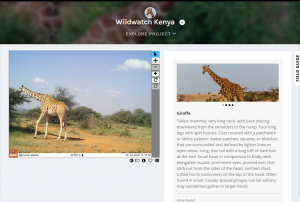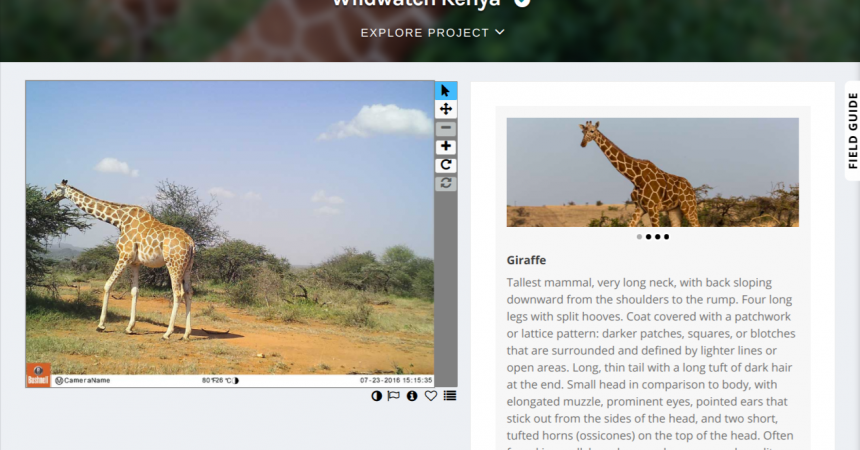Zoo InternQuest is a seven-week career exploration program for San Diego high school juniors and seniors. Students have the unique opportunity to meet professionals working for the San Diego Zoo, Safari Park, and the Institute for Conservation Research, learn about their jobs, and then blog about their experience online. Follow their adventures here on the Zoo’s Website!
 When you think of vulnerable and endangered species in Africa, you might think of rhinos, elephants, or lions. However, the animal that most don’t even realize is having trouble is the giraffe. Surprisingly, scientists don’t actually know much about giraffes despite how iconic they might seem. Currently, there are nine subspecies of giraffe, but it has been proposed that there are actually four separate species. At San Diego Zoo Global’s Institute for Conservation Research, the Global Partnerships Team is focusing its work in northern Kenya with reticulated giraffe population. In the past 20 years, giraffes in general have decreased in population by about 40% while reticulated giraffes have declined by about 70%. There are a couple threats to giraffes that led to these declines. First, habitat loss and fragmentation due to human expansion mean giraffes don’t have as much space to live or sources of food to support their population. Additionally, as people graze their livestock, it degrades the land quality so that the giraffes don’t have enough resources to support a larger population. The last threat is poaching. Giraffes actually aren’t poached as often for the reasons that elephants or rhinos might be. In Kenya, they’re mostly hunted as a source of food while other places believe their bone marrow has healing properties or use their tails as a dowery.
When you think of vulnerable and endangered species in Africa, you might think of rhinos, elephants, or lions. However, the animal that most don’t even realize is having trouble is the giraffe. Surprisingly, scientists don’t actually know much about giraffes despite how iconic they might seem. Currently, there are nine subspecies of giraffe, but it has been proposed that there are actually four separate species. At San Diego Zoo Global’s Institute for Conservation Research, the Global Partnerships Team is focusing its work in northern Kenya with reticulated giraffe population. In the past 20 years, giraffes in general have decreased in population by about 40% while reticulated giraffes have declined by about 70%. There are a couple threats to giraffes that led to these declines. First, habitat loss and fragmentation due to human expansion mean giraffes don’t have as much space to live or sources of food to support their population. Additionally, as people graze their livestock, it degrades the land quality so that the giraffes don’t have enough resources to support a larger population. The last threat is poaching. Giraffes actually aren’t poached as often for the reasons that elephants or rhinos might be. In Kenya, they’re mostly hunted as a source of food while other places believe their bone marrow has healing properties or use their tails as a dowery.
The Global Partnerships Team works with two conservancies in Kenya, Namunyak Wildlife Conservancy and Loisaba Conservancy. Namunyak is a much larger conservancy with communities living inside, while Loisaba is much smaller and easier to manage. In San Diego, Jenna Stacy-Dawes, a research coordinator, and Nikki Egna, a contracted research associate, work on interpreting data and managing the project from afar. On the ground in Kenya, local people are employed as “giraffe guards,” collecting data and working with the local communities. Using these local people with preexisting reputations and and relationships with the residents accelerates the process of educating the people about giraffe conservation.
One job they perform is photo monitoring. They drive around until they find a tower, or group, of giraffes then record some data about them. The conservationists determine the sex of each giraffe and note the type vegetation and terrain nearby. That information helps them make heat maps that visually show where they find giraffes more often. When they see them, they also take a picture of the right side of each individual. These photos are run in a type of facial recognition or coat recognition software to track where individuals go over time.
Tracking devices called solar powered ossicone units are also attached to giraffes. These devices are wrapped around the horn-like structures on giraffes’ heads. In order to attach the trackers, a team of people need to work together. After they find a giraffe, a vet calculates the dosage and tranquilizes the animal. The team follows the animal until it shows signs of the medication taking affect. At that point, a team will use ropes to help lower the giraffe gently to the ground and the vet will administer the reversal drug. The group then has ten minutes to attach the ossicone unit and collect biodata. Information they gather such as tail, head, and other measurements and DNA samples from blood, hair, and skin might not even have an immediate purpose. They use the opportunity of having a sedated wild giraffe to collect as much information as possible that might be useful later on. With the trackers, Ms. Stacy-Dawes and Ms. Egna can watch how a giraffe is moving, compare where they are in the wet and dry seasons, and hypothesize why they may favor certain areas due to factors such as vegetation and terrain. Since this project started last June, only about ten units have been placed on giraffes. However, as the project grows, they hope to buy more units to collect more data and find answers to these questions.
Workers in Kenya also ask community members questions to gather information called human dimensions. They ask questions like whether they or someone they know has eaten giraffe meat in order to gage the general attitudes toward giraffes in their community and determine where they need to focus their efforts to educate the populace. They also ask questions about where they see giraffes while grazing their livestock and whether those places have changed over the years. While these personal testimonies can be slightly inaccurate, they help build a general history of giraffes in the area.
Another important part of their work is the system of trail cameras installed throughout both conservancies. The cameras are motion sensitive and will take a picture about every three seconds if it’s being continually triggered. Trail cameras capture photos of not only the wild animals, but also grazing livestock. By watching how long it takes for wild animals to return after livestock come through an area, Ms. Stacy-Dawes and Ms. Egna can determine whether and to what extent species are affected by livestock presence. Trail cameras also generally help them learn about the ecosystem in general and what types of areas giraffes frequent. These photos are uploaded to wildwatchkenya.org where anyone can help browse through photos, identifying any animals caught on camera.
Ms. Egna’s main job is to interpret the trail camera photo data and other data. She also spends her time going through the photos and creating algorithms to determine how many of the 15 people who look at each photo need to agree in order to be sure that it’s the correct ID. Ms. Stacy-Dawes focuses on interpreting data through maps and talking to people and answering their questions about reticulated giraffe conservation. She also uses the data that Ms. Egna interprets to write research papers and publish their findings.
In order to help maintain this project and aid reticulated giraffe research, you can spend time using the wildwatchkenya.org website. There you can discover seen photos of wildlife while helping Ms. Stacy-Dawes and Ms. Egna in the Institute’s Global Partnerships Team with their work. It’s a relatively easy and mindless way to be apart of the effort to help such a beautiful and loved creature.
Carly, Conservation Team
Week Six, Winter Session 2018


